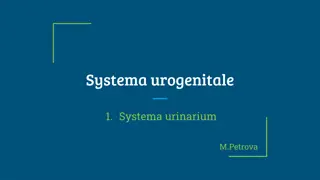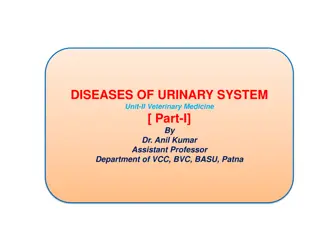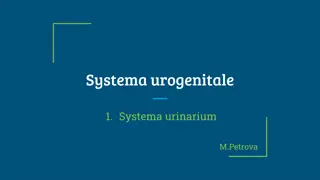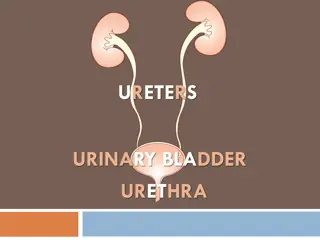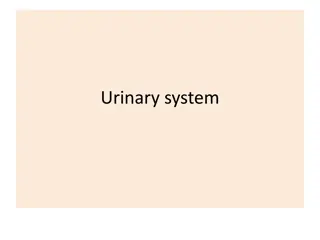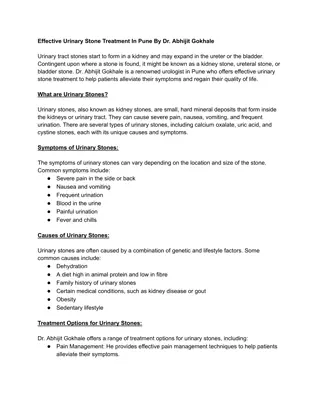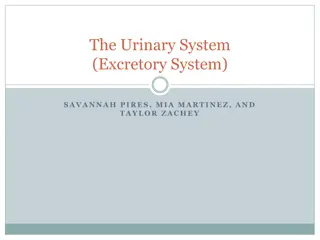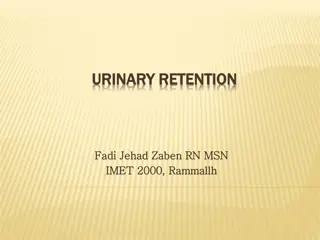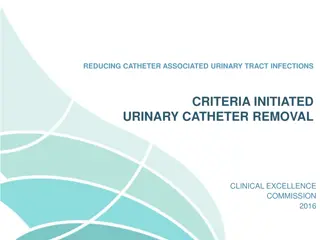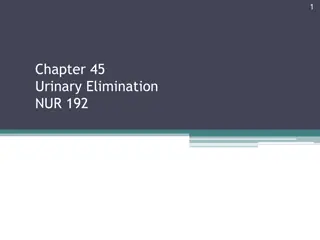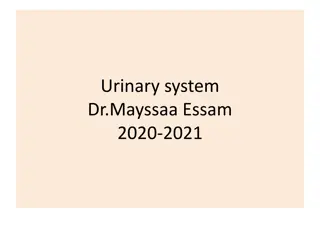The Essentials of the Urinary System
The urinary system plays vital roles in maintaining internal balance, filtering fluids, regulating blood volume and pressure, and producing essential hormones. Consisting of organs like the kidneys, ureters, bladder, and urethra, the system functions through processes like urine formation, tubular reabsorption, and secretion. Understanding the intricate structures and functions of the urinary system is crucial for overall health and well-being.
Download Presentation

Please find below an Image/Link to download the presentation.
The content on the website is provided AS IS for your information and personal use only. It may not be sold, licensed, or shared on other websites without obtaining consent from the author.If you encounter any issues during the download, it is possible that the publisher has removed the file from their server.
You are allowed to download the files provided on this website for personal or commercial use, subject to the condition that they are used lawfully. All files are the property of their respective owners.
The content on the website is provided AS IS for your information and personal use only. It may not be sold, licensed, or shared on other websites without obtaining consent from the author.
E N D
Presentation Transcript
I. Functions A. Maintain and purify internal medium B. Filter body fluids eliminating excess electrolytes and wastes C. Return needed materials to circulatory system D. Regulate blood volume and chemical make-up E. Renin-helps to regulate blood pressure F. Erythropoietin-red blood cell production
II. Organs of urinary system A. Kidneys B. Ureters C. Bladder D. Urethra
III. Kidney Details A. Retroperitoneal superior lumbar position B. Size 1. five inches long 2. three inches wide 3. one inch thick C. External features 1. hilum 2. adrenal gland 3. fibrous capsule 4. perirenal fat capsule 5. renal fascia anchors to muscles of trunk wall
D. Internal anatomy 1. renal cortex 2. renal medulla 3. renal pyramids 4. renal columns 5. renal pelvis 6. calyces
E. Nephron structure 1. Functional unit 1. Bowman s capsule- podocytes or filtration slits 2. Proximal convoluted tubule 3. Loop of henle 4. Distal convoluted tubule 5. Collecting duct 6. Cortical vs. juxtamedullary nephrons
F. Circulatory supply to nephron 1. Afferent arteriole 2. Glomerulus 3. Efferent arteriole 4. Peritubular capillary bed 5. Diameters of two vessels
III. Urine formation A. Filtration 1. nonselective 2. passive process 3. everything but RBC and large proteins 4. essentially plasma without proteins 5. huge amounts formed-150 liters of filtrate
B. Tubular reabsorption 1. Useful as well as wastes 2. Begins in prox conv tubule 3. Cells transport 4. Glucose, amino acids, electrolytes 5. Not reabsorbed-urea, uric acid, creatine 6. Absorbed into peritubular capillary beds 7. http://www.youtube.com/watch?v=glu0dzK4dbU
C. Secretion 1. Moving materials from the distal convoluted tubule to the efferent arteriole 2. H and K ions and creatinine 3. Certain drugs 4. Moving materials to help control pH
D. Creation of a concentrated urine 1. Remember that water follows salt 2. Loop of henle 3. Ascending limb actively pumps salt out and is impermeable to water 4. Descending limb permeable to water but not salt 5. Salt gradient is formed 6. Collecting ducts are variably permeable depending on presence of ADH
IV. Other organs of system A. Ureters 1. Approximately 10-12 inches Travel from hilum to posterior aspect of bladder Peristaltic movement of urine Continuous with renal pelvis Renal calculi lithotripsy 2. 3. 4. 5. 6.
B. Bladder 1. Three openings 2. Trigone-infections persist here 3. Prostate 4. Transitional epith 5. May hold two pints of urine 6. Urethritis 7. Cystitis


